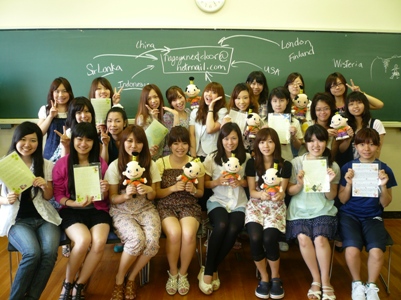|
Coincidences and context led to an international
communication project called Nagoya Next Door (NND). Developed for
English as a foreign language (EFL) classes at a Japanese university,
the NND project aimed to incorporate culture and international
communications in an imaginative way using the Internet. This report is a
synopsis of the NND project and activities implemented for a Japanese
university EFL class.
The development of an EFL class at a Japanese university began
with the goal to adapt an Internet communication strategy. All one need
do is ponder the popularity of cell phones, Facebook, blogs, and the
virtual explosion of information available worldwide. And yet in the
world of instant communications, the Internet can be a paradoxically
anonymous interaction. Cyber-identities and virtual worlds are contrived
realities, not the end point desired for this class. Coincidences
turned this challenge into an opportunity. I had experience with
friendship-doll exchanges from the Japanese Friendship Doll Program at
Mukogawa Gakuin inspired by the 1927 Doll Plan exchange between the
United States and Japan, and the Flat Stanley Project in which my
daughter had participated. I knew the power of a friendly doll face and
the personal nature of the communication. A project synergy developed
from the concept of friendship dolls, a Nagoya City promotion, and the
application of Internet communications in EFL learning (Belcher, 2006;
Hawisher et al., 2006; Savignon & Sysoyev, 2002; Takaoka, 2004;
Yashima, 2002).
A DOLL―REALLY?
There were many Internet options but was there a doll that fit
this EFL context? Coincidentally, the city of Nagoya was about to launch
a major promotion in 2010: the 400th anniversary of Nagoya City. This
campaign promoted the
city domestically and around the world and featured a
charming mascot doll called Hachimaru. The potential was
apparent:
- Doll whose universal appeal was charming
- Oversee replies/progress on the Internet
- Learning where EFL was fun and personal
- Leverage partnerships for participation
With a clear vision for the project, we received financial
support and endorsements from my Japanese university, the city of
Nagoya, and the Nagoya International Airport called Centrair. In
addition, there was a waiting list for those who wanted to
participate.
NND PROJECT
The basic project design was to use the Nagoya mascot doll,
Hachimaru, as a friendship courier, designating each doll with a unique
flower surname to track their travels. Each Hachimaru doll was sent with
welcome letters from EFL students and the mayor of Nagoya, information
about Nagoya; Internet links, directions, and a key-chain charm.
Recipients were asked to send a picture of Hachimaru in their city and
some information about their city to our Internet site. After 4 weeks, the recipients were instructed to send Hachimaru to a new
friend and keep the souvenir key-chain charm but add a new key-chain
charm iconic to their city. The next recipients then repeat the process.
The purpose was to connect recipients and create a friendship network
through which people became friends― just as if they were next door.
“Hachi” of Hachimaru means “eight” and fittingly, 88
percent of initial recipients responded, with 75 percent of secondary
recipients and 60 percent of tertiary recipients also responding. Each
Hachimaru doll had a securely fastened name tag with the Internet sites
for replies and access as follows:
- Replies and Reports directed to:
- Project Account Access at Windows Live&™
- Secondary Blog Site:

Thirty-two Hachimaru dolls were sent initially to 10 countries
on four continents in white, custom-made, sturdy plastic boxes.
Recipients willing to participate in the endeavor and relevant to our
context were selected from the following sources:
EFL ACTIVITIES
The NND project provided a range of activities for EFL classes
including writing, international travel, Internet communications, and
oral discussions as follows:
- Students wrote welcome letters in English and Japanese that
accompanied the Hachimaru doll. The letters featured favorite Nagoya
sightseeing spots and regional foods.
- In an international exchange to China, a delegation of
university students met with Chinese students and performed a skit in
English and Chinese that explained the NND project at the Japanese
Pavilion during the Shanghai World Expo in Shanghai, China.
- Internet interactions included e-mail pals/exchanges with
American middle school and elementary students. EFL writing class
incorporated the process of drafting and rewriting. But in the third
year, EFL communications class students wrote directly to pen pals and
on the blog.
- Oral discussions enabled and challenged students to
contextualize the content from Web site photos, and each presentation
included a question for their peers promoting further discussions.
Students engaged and were transformed into teachers.
JUST LIKE NEXT DOOR
The NND project was an EFL opportunity created for the Internet
that embraced friendship and the personal nature of communication. The
charming face of Hachimaru was amazingly disarming. And surprisingly,
whether young or old, at a World Expo in China or chillin’ with students
on the steps in Liverpool England, Hachimaru had an amazing ability to
open people’s hearts. Hachimaru in hand, strangers became friends―just
like they lived next door. Not such a coincidence.

REFERENCES
Belcher, D. (2006). English for specific purposes: Teaching to
perceived needs and imagined futures in worlds of work, study, and
everyday life. TESOL Quarterly, 40(1), 133-156.
Hawisher, G., Selfe, C., Guo, Y., & Liu, L. (2006).
Globalization and agency: Designing and redesigning the literacies of
cyberspace. College English, 68(6),
619-636.
Savignon, S., & Sysoyev, P. (2002). Sociocultural
strategies for a dialogue of cultures. The Modern Language
Journal, 86(4), 508-524.
Takaoka, M. (2004). Doll ambassadors: An alternate history of
U.S.-Japan relations. Tokyo: Nikkbei Publishing.
Yashima, T. (2002). Willingness to communicate in a second
language: The Japanese EFL context. The Modern Language
Journal, 86(1), 54-66.
Patrice Pendell, patricependell@yahoo.com,
resides and teaches in Japan and received her BS and BEd from Eastern
Washington University and MA and TESOL Certification from Gonzaga
University. Her research interests include international communications,
Japanese storytelling (kamishibai), and leadership with women models. |

